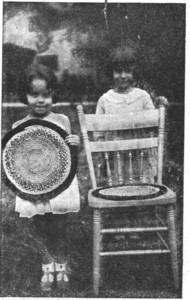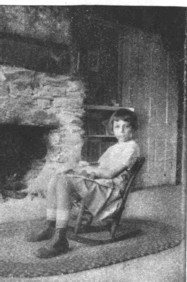Two1932 Braided Rug Articles
What follows are two articles on braided rugs and mats from the August, 1932 "Needlecraft" Magazine. The prose may be a bit florid from a modern view point, but the text is quite touching. Remember these articles appeared at the depths of the Depression, and I know many of you will recognize the phrase "making something from nothing" in the second article on braided rugs from gunny sacks.
(1932) BRAIDED CHAIR-SEATS ARE IN VOGUE by Minnie E. Williams
 The sphere of the braided rug has enlarged since great grandmother's
time. No longer must it remain solely underfoot in order to "keep its place". Just note the Lilliputian affairs so proudly displayed
by two smiling little ladies! (Photo caption: "Josephine and Katherine wish to show you how the mats look when finished.) These are intended for chair-seats, and are as comfortable and good-looking as can be. A step or two
higher in the scale and we see them serving in delightful fashion as hot dish mats for the table; there seems, indeed no limit to
the uses that may be found for this simple old-time handicraft.
The sphere of the braided rug has enlarged since great grandmother's
time. No longer must it remain solely underfoot in order to "keep its place". Just note the Lilliputian affairs so proudly displayed
by two smiling little ladies! (Photo caption: "Josephine and Katherine wish to show you how the mats look when finished.) These are intended for chair-seats, and are as comfortable and good-looking as can be. A step or two
higher in the scale and we see them serving in delightful fashion as hot dish mats for the table; there seems, indeed no limit to
the uses that may be found for this simple old-time handicraft.
Materials vary--a great deal depending, of course, on the purpose for which the completed piece is intended. For table-mats--which may be of any desired size, round or oval--white or unbleached cotton will serve, with a touch of color, if liked, given by having one strand of a shade which matches the predominating tint of the china, perhaps; or there may be a bit of colorful embroidery in simplest stitch. Again, two colors of chambray or other goods of similar texture may be used, or white for the center of the mat with a braid in color for the border.
Ample opportunity is sure to be found for the exercise of one's creative genius, in any case; and no matter how material, coloring and uses may differ, the methods of making are practically the same. The rags are cut or torn in strips an inch and a half in width--wider for thin goods--both edges are evenly turned under and then the strip is folded lengthwise in the middle. By this means no raw edges are in evidence. Some workers like to iron the strips, thinking the folds stay in place better; others, especially when using heavier worsted material, advocate cutting the strips narrower and simply turning the edges under, omitting the middle fold. In this way their right side of the braid--and the mat-- is kept free from any appearance of frayed or raw edges and the finished piece, lined, has an equally smooth wrong side, but of course can only be used "right side up with care", while if the strips are prepared as directed the rug or mat is reversible. By a little experimenting one can readily determine the method best suited to her requirements and material.
The three-strand braid is commonly used, being easiest to handle and sew, and better in case of small articles, for which indeed, the wider braids-- of four, five, six and seven strands are not easy to manage. The mats which our small friends are showing us are of three-strand braids, with the making of which doubtless everyone is familiar. Using any color or colors desired, one, two, or three, join one end of each of the three strips and attach to any convenient object heavy enough to hold while the strands are evenly woven. Pick up the first or right-hand strand, carry it over the second or middle strand, then pick up the third or left-hand strand, bring it to the right over the first, which is now the middle strand, then take the strand at the right again, and continue; that is all there is to it; a simple weaving back and forth. Do not draw the strands too tightly; just keep a firm, even tension. When it is necessary to joint two strips simply fold the end of one over that of the other, half an inch or so, and sew both sides carefully.
Having braided a sufficient length for the center of the mat, "begin at the beginning" of the braid, fold it to form a tiny circle, sewing securely, then carry the braid around and around, drawing it in on the inner or fulling it on the outer side, and sewing edge to edge with strong thread, well-waxed. Add rows of other colors, as liked. Completed the mat should lie flat and smooth. There are different ways of doing the sewing; the old-time method of joining the edges was by means of small over-and-over stitches or ball-stitch--taking first into one edge, then the other Another method thought by at least one good rug maker to be the best ever, uses twine or carpet warp and a bodkin or blunt needle of sufficient size to take the thread; pass through every other loop on both edges, not catching into the braid itself. To make the joining extra strong go over it a second time, taking into the loops missed before. This method makes the work the same on both sides, and is really easier than the usual sewing.
(1932) GUNNY SACKS "STEP OUT" by Sarah Gibbs Campell
 Yes, in the language of the younger generation, gunny-sacks do step out of
the feed-room and barn, by way of the dye-pot, to the sun-parlor or living porch, reappearing as a colorful ensemble of braided rugs
for the floor and mats or seats for swings, benches and wooden chairs, comfortable, durable and most attractive. New burlap may be
used, if preferred, but--aside from the expense--every one among us who professes the true creative spirit enjoys "making something
of nothing"; and the sacks, after having been properly washed and boiled, are soft in texture, can be dyed any shade desired, and
their natural color blends beautifully with every other, dark or light.
Yes, in the language of the younger generation, gunny-sacks do step out of
the feed-room and barn, by way of the dye-pot, to the sun-parlor or living porch, reappearing as a colorful ensemble of braided rugs
for the floor and mats or seats for swings, benches and wooden chairs, comfortable, durable and most attractive. New burlap may be
used, if preferred, but--aside from the expense--every one among us who professes the true creative spirit enjoys "making something
of nothing"; and the sacks, after having been properly washed and boiled, are soft in texture, can be dyed any shade desired, and
their natural color blends beautifully with every other, dark or light.
(PHOTO CAPTION:
Introducing little Miss Campbell of San Antonio, Texas, and the gunny-sack rug)
In method these rugs differ somewhat from those for which ordinary material is used. After the sacks are cleansed, ripped and dyed they are cut lengthwise in strips or strands three inches wide, following a thread so they will be perfectly straight and easily folded; I find it is better to cut the strips as they are used, or but few of each color at a time, as the loose weave of the material causes them to ravel very easily. Turn the edges under one-half inch, then fold along the center evenly, pressing firmly between the fingers, thus forming a doubled strip one inch in width. Several lengths may be folded at a time as directed, and pressed with a heavy iron; but I find that if I do them as they are needed the result is better.
Braid firmly and evenly, taking care that all raw edges are folded in, and do not pull too tightly. When a new strip must be added, turn back a half-inch of each end to be joined, on the wrong side, and whip these ends together with a thread of the material, taking up only a thread or two in the seam, press flat, fold the new strip and overcast the folded edges at the seam. The joinings will be scarcely noticeable; one should take care, however, that they do not come too close together in the braid, for while one will not show, two or three may produce an unsightly bulge.
It is easier, I find, to sew these rugs as they are braided; not only are they rather heavy to handle, but the rows of each color must be even, and it is difficult to determine just how much of the braid is necessary to reach a certain point. While sewing, it is better to place the rug flat on a table or other smooth surface; allow sufficient fulness at the curved ends, and use very strong thread, either waxed linen or crochet-thread, making the stitches close and firm. If both braiding and sewing are well done, as directed, the rugs are practically indestructible, and very easily cleaned.
Exactly the same methods are employed in making the mats, one of which can be completed in a few hours. Not more than two of the sacks will be required for a mat of convenient size--sixteen or eighteen inches in diameter, so by having a variety of pretty shades, some delightful color-combinations can be worked out. As suggested, there are many uses, for these smaller creations.
The choice of colors is, of course, one's own. For my living-porch I have just finished a large oval rug, thirty-two by sixty-three inches of orange, brown and the natural color of the sacks. First, I doubled a thirty-inch strip of natural and orange--two strands of natural and one of orange--sewing the edges evenly and securely, then turned the braid around the raw end, covering it completely and holding the curve full enough to make it smooth and flat. This combination--orange and natural--was continued until there were six rows from the center, then the orange strand was changed to golden-brown. After two rows of this, one strand of the natural was changed to brown of the same shade, three rows added, and for the remaining three rows a slightly darker brown was used instead of golden-brown. This method of changing from light to dark is just as effective and much easier than to finish off a row each time a change is made.
Such a rug may be of any desired size and shape, or combination of colors, and will be found extremely fascinating in the making.